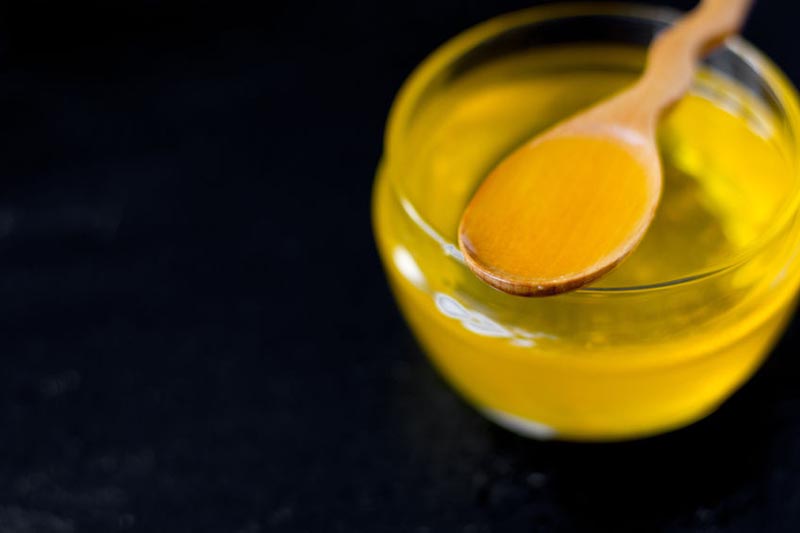Clarified butter, also sometimes referred to as drawn butter, is butter that the water has been allowed to evaporate and milk solids are removed, leaving only butterfat. You end up with a clear, golden buttery liquid. The process is simple and you can clarify butter on your own stove in a matter of minutes. Then, use clarified butter to make rich sauces, bake with, or on toast.
Stay tuned in to recipes using clarified butter! I’ll link them on this page:
This recipe is available to everyone.
How can I use clarified butter?
You can make rich sauces using clarified butter. You may have heard of hollandaise sauce, but what about bechamel (pronounced: bay shoe mel)? Bechamel sauce turns into several different sauces. French recipes often call for clarified butter as do Indian recipes. Indian recipes may refer to the term ghee instead of clarified butter.
Sauces are not the only thing you can make with clarified butter. You can use it to bake too. Your baked goods and fried food will be less likely to burn due to its higher smoke point and be moister.
What is the smoke point of clarified butter?
The smoke point of clarified butter is 485ºF.
Clarified butter is pure pleasure to use on toast and bread rolls, too. Take your leftover clarified butter and heat it on the stove with some salt. When you have guests over next time, place the salted clarified butter in a mini dessert mold and refrigerate until firm. Unmold the butter onto a small dish and leave it out at room temperature for a little while prior to your event. The presentation is stunning and the flavor is rich.
How long does clarified butter last?
To make clarified butter, you need to use unsalted butter. Salt helps preserve butter. Without salt, butter can spoiler faster. Due to the removed milk solids and water, clarified butter will stay fresher longer than traditional unsalted butter.
You may understand why removing milk solids from butter would extend its shelf life, but may be confused about why removing water from butter would extend its shelf life. Take a look at things that mold. Bread contains water and sometimes milk and it molds. Cheese contains both water and milk solids and it molds. What doesn’t mold easily? Look at how long raisins last or other dried fruit. What is missing from dried fruit? Water! As fruit dries or dehydrates, water evaporates.
Manufacturers struggle with this very thing on a daily basis. They need to extend the shelf life of their products and hire me to adapt their recipes. One of the first things I do is remove as much liquid from the recipe as possible.
Can I use salted butter to make clarified butter?
No. Salted butter is not recommended to make clarified butter because once the butter’s water evaporates, you end up with a concentrated amount of salt.
What should I do if my clarified butter browns?
If you were busy doing other things and your clarified butter turns brown, you can still use it. Ghee, an Indian version of clarified butter, is often cooked to this color. It provides a caramel flavor. Just realize that you will be giving a slight color to whatever you add it to.
However, if you have burnt your butter, discard it and start over. It is important to watch over your butter and/or keep an ear open for when the water stops boiling. Once all of the water evaporates, the boiling will stop.

How to make clarified butter in an easy to understand manner. Make this rich butter in about 15 minutes to use in rich sauces, Indian dishes, baked goods, and on toast.
Ingredients:
- 1 cup/16 tablespoons (2 sticks) unsalted butter
Instructions:
- Melt the butter in a heavy saucepan over medium-low heat (medium heat if you want the brown/caramel version) and slowly cook until the bubbling stops. (This means all of the water has boiled out of the butter.) The liquid will be clear and you'll see milk solids at the bottom of the pan and some floating on top. This takes about 15 minutes. Watch the butter carefully. It can go from golden to brown in a heartbeat.
- Skim off the top foam using a metal strainer, perforated spoon, skimmer, etc.
- Strain and set aside to cool. (When straining, do not allow any solids to be strained as some can get passed your fine mesh strainer. Leave them at the bottom of the pan and discard. Store any leftovers in an airtight, heat-proof container in the refrigerator up to a month.
Tips
*When using European unsalted butter, you will end up with about 3/4 cup + 2 tablespoons of clarified butter. European butter contains a higher amount of fat and less water. Therefore, if you use non-European butter, expect the recipe to yield less clarified butter. I purchase unsalted European butter at Costco in a 4-pound box.

